Ever wondered why one skincare product stands out on the shelves while another sits unnoticed? Packaging plays a critical role in consumer perception and purchase decisions.
With years of experience in the paper bag making machine sector, we’ve become experts in the field of packaging, particularly in relation to the cosmetic industry.
The types of cosmetic packaging not only add aesthetic appeal but also offer functionalities such as protecting the product, extending its shelf life, and facilitating ease of use.
In this guide, we’ll delve deep into the various types of cosmetic packaging, offering actionable insights that can add real value to your brand, whether you’re a start-up or an established business.
Read on to elevate your packaging game!
1. The Importance of Cosmetic Packaging
When it comes to cosmetics, packaging is more than just a protective casing. It serves as the first point of interaction between the consumer and the brand. Attention-grabbing design, high-quality material, and functional elements can collectively elevate the product’s market standing.
In an industry where consumers are faced with an abundance of choices, effective packaging sets a product apart. The right package can attract attention, evoke emotions, and facilitate purchase decisions. With my experiences I witnesses how packaging becomes a vital component of brand identity and consumer perception.
In addition to aesthetic considerations, packaging serves practical purposes. It preserves the product’s integrity, extends its shelf life, and ensures ease of use. Considering all these factors, it’s clear that understanding the different types of cosmetic packaging is indispensable for industry players.
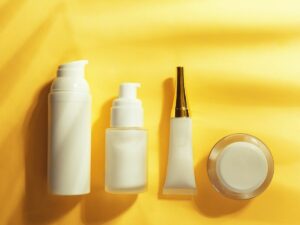
2. Different Types of Cosmetic Packaging
Packaging choices significantly influence a cosmetic brand’s success. A variety of types and materials exist to cater to different product requirements. Here are some of the most common types:
Bottles and Jars
Materials
- Glass: Glass provides a high-end look and excellent barrier properties against moisture and gas. However, it is heavier and more fragile than other materials.
- Plastic: Plastic is lightweight and less prone to breakage. It offers flexibility in design but may not offer the best barrier properties for certain formulations.
- Aluminum: Aluminum bottles are strong, lightweight, and recyclable. They provide excellent barrier properties but can be more expensive.
Applications
- Liquids: Ideal for toners, lotions, and liquid foundations, bottles come with various dispensing options.
- Creams: According to Paramount Global, with jars wide opening, it becomes a go-to for creams as they allow for easy access and scooping.
- Serums: Bottles, particularly those with dropper mechanisms, are suitable for serums which are generally applied in small quantities.
Pros and Cons
Pros:
- Versatile in design and size
- Suitable for a wide range of products
- Recyclable materials available
Cons:
- Glass and aluminum options can be expensive
- Potential for product waste in jar formats

Tubes
Materials
- Laminate: Laminate tubes are multi-layered and provide good barrier protection. They are often used for toothpaste and can be cost-effective.
- Plastic: Plastic tubes are lightweight, flexible, and less likely to dent or puncture. However, they may not provide optimal barrier protection for certain formulas.
- Aluminum: Aluminum tubes are strong and provide excellent barrier properties, making them ideal for products that are sensitive to light and air. However, they can be susceptible to denting.
Applications
- Toothpaste: Often housed in laminate or aluminum tubes to keep the formula stable and free from contaminants.
- Gels and Ointments: These are typically stored in plastic tubes due to their light weight and low cost.
- High-End Creams: These often use aluminum tubes for their excellent barrier properties and premium appearance.
Pros and Cons
Pros:
- Ease of application directly onto skin or other surfaces.
- Good portability and travel-friendliness.
- More hygienic due to one-way flow of the product.
- Variety of sealing options for product freshness.
Cons:
- Some materials like aluminum can be dented easily.
- Limited capacity due to tubular shape.
- May require additional inner lining for certain formulations, adding to costs.

Dispensers and Pumps
Materials
- Plastic: Most common due to its lightweight and cost-effective nature, plastic pumps are versatile but may not be ideal for highly viscous products.
- Stainless Steel: Offers a premium look and excellent durability. Often used in high-end products but can be expensive.
- Glass: Provides a luxurious feel and effective barrier properties. Used in perfumes and premium skincare lines, but is heavier and riskier to transport.
Applications:
- Lotions and Creams: With thicker formulations like lotions and creams, dispensers are truly your best friend. Delivering precise, controlled amounts per pump, ensuring that not a drop goes to waste.
- Liquid Soaps and Cleansers: Pumps are usually used for these, providing convenience and hygiene.
- Foundation and Primers: Some brands opt for pump applicators for liquid makeup products to offer better portion control and reduce waste.
Pros and Cons
Pros:
- Excellent for portion control.
- Enhances user experience by providing convenience.
- Generally more hygienic as product isn’t exposed to air or contaminants.
- Suitable for a range of viscosity levels depending on the pump mechanism.
Cons:
- Pump components can add to the overall packaging cost.
- May not be ideal for products that require mixing before use.
- Potential for mechanical failure, affecting product dispensing.
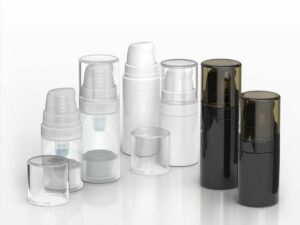
Droppers and Pipettes
Materials
- Glass: Offers excellent barrier properties and a premium look, but is fragile and heavier compared to other materials.
- Plastic: Provides flexibility and is lightweight, but may compromise on barrier properties for certain active ingredients.
- Silicone: Often used for the dropper bulb, silicone is flexible and offers good chemical resistance but may not be suitable for all types of formulas.
Applications
- Serums: Droppers and pipettes are often used for serums. The dropper allows consumers to extract just the right amount of product, ensuring that nothing goes to waste, a key consideration for high-value items.
- Essential Oils: The concentrated nature of essential oils makes accurate dosing crucial, both for efficacy and safety. Droppers offer the necessary precision, making it easier for professionals in salons and spas, to blend oils or apply them directly.
- Tinctures: While not strictly cosmetic, tinctures are common in the broader personal care market, often being sold alongside cosmetics. They can contain herbal extracts that promote skin health, and droppers are ideal for their liquid consistency and the need for precise measurement.
Pros and Cons
Pros:
Allows for precise application and dosage.
Offers a more controlled usage experience, minimizing waste.
High perceived value, enhancing the premium nature of the product.
Can be sterilized easily, providing a more hygienic option.
Cons:
Glass options can be fragile and prone to breakage.
More complicated assembly can result in higher packaging costs.
Some materials may interact with the product formula, affecting its efficacy.

Compacts and Palettes
Materials
- Plastic: Frequently used due to its lightweight nature and cost-effectiveness, plastic is versatile but may lack a premium feel.
- Metal: Often used for high-end products, metal compacts offer durability and a luxurious touch but can be heavy and expensive.
- Bamboo and Wood: Growing in popularity for their eco-friendly aspects, these materials offer a unique aesthetic but may lack the durability of plastic or metal.
Applications
- Powders and Blushes: Compacts are ideal for these products, offering a secure case with a mirror for on-the-go applications.
- Eyeshadows: Palettes offer multiple shades in a single case, usually with an applicator and mirror. Nako Cosmetics have really elevated the experience by combining high pigment quality with durable packaging.
- Multi-product Kits: Some palettes offer a combination of products like eyeshadows, blush, and lipstick for a complete makeup solution.
Pros and Cons
Pros:
- Provides a range of product options in one package.
- Convenient for travel and touch-ups.
- Mirrors and applicators add to the user experience.
- Customizable in terms of design, shape, and components.
Cons:
- Can become bulky depending on the number of products included.
- Complex construction can add to the cost.
- Some materials may not provide optimum barrier protection for certain formulations.
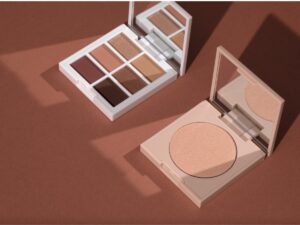
Roll-Ons and Sticks
Materials
- Plastic: Commonly used for its cost-effectiveness and lightweight nature, plastic roll-ons are versatile but may lack barrier properties for certain products.
- Metal: Provides a cooling effect during application and is often found in premium skincare lines. However, metal containers can be heavier and more expensive.
- Glass: Offers excellent barrier properties and a premium aesthetic but is less impact-resistant and heavier for transportation.
Applications
- Deodorants: Roll-ons are a popular choice for deodorants, providing a mess-free application.
- Lip Balms and Glosses: Stick applicators are ideal for these products, offering portability and ease of use.
- Solid Perfumes: Sticks provide a compact and spill-proof way to carry and apply solid fragrances.
Pros and Cons
Pros:
- Convenient and portable, ideal for on-the-go applications.
- Allows for targeted application, reducing product wastage.
- Generally more hygienic as the product is less exposed to air and contaminants.
- Available in various sizes and styles, offering brand differentiation.
Cons:
- Limited to specific product textures and formulations.
- The rolling ball or stick can sometimes get stuck, affecting product dispensing.
- Some materials may not be suitable for all formula types, requiring thorough compatibility testing.

Sachets and Pouches
Materials
- Laminated Films: Frequently used for sachets, these materials offer good barrier properties and are cost-effective but may not be easily recyclable.
- Foil: Provides excellent barrier properties against light, oxygen, and moisture. However, it can be less flexible and more costly.
- Biodegradable Polymers: Growing in demand for their eco-friendly aspects, these materials are compostable but may lack optimal barrier properties.
Applications
- Sample Products: According to Fillcon, sachets are extremely effective at keeping products airtight and protected from contaminants. Sachets are commonly used for product samples, given their low cost and single-use design.
- Facial Masks: Pouches with multiple layers and sealing technologies keep these products moist and well-preserved. Nako Cosmetics employs such sachets to ensure the longevity and efficacy of their facial masks.
- Shampoo and Conditioners: Ideal for travel or single-use scenarios, sachets offer convenience and portion control.
Pros and Cons
Pros:
- Cost-effective for both manufacturer and consumer.
- Excellent for promotional samples or travel-sized versions of products.
- Offers precise portion control, reducing waste.
- Easy to produce in large volumes, optimizing manufacturing efficiency.
Cons:
- Limited reusability, leading to potential waste.
- Less robust barrier properties compared to other packaging types.
- May require secondary packaging for branding or additional protection, increasing costs.
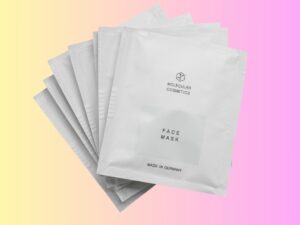
3. 7 Factors to Consider in Cosmetic Packaging
When contemplating cosmetic packaging options, multiple factors come into play. Here are key elements to ponder upon for impactful packaging.
- Material Choices: Selecting the right material for cosmetic packaging is crucial for both aesthetic and functional aspects. Plastics, for instance, are often preferred for their versatility and affordability, but there is a rising trend toward sustainable materials like glass and paper.
- Design and Shape: A well-thought-out design not only grabs consumer attention but also complements the brand’s overall aesthetics. Taking into consideration ergonomics can facilitate ease of use, which is a considerable factor in customer satisfaction.
- Printing and Labeling: Labeling must adhere to industry regulations, including listing ingredients and any necessary warnings. Use high-quality printing methods, for example, UV printing or flexography for durability and a polished look.
- Safety Measures: Features like tamper-evident seals, can go a long way in building consumer trust. This is particularly important for products like skincare serums or medications that require a sterile environment.
- Regulatory Compliance: Cosmetic packaging must adhere to a host of regulations that vary by jurisdiction. This includes labeling requirements, the use of certain materials, and safety guidelines.
| Aspect |
Description |
Example/Implication |
| Labeling Requirements |
Cosmetic products must have specific information displayed on their packaging. |
Ingredients list, expiration date, and usage instructions might be mandatory in certain jurisdictions. |
| Material Usage |
Certain materials may be restricted or banned in cosmetic packaging due to environmental or health concerns. |
In some regions, the use of certain plastics or harmful chemicals in packaging might be prohibited. |
| Safety Guidelines |
Packaging must ensure the safety of the product and the consumer. |
Child-resistant packaging for certain products or tamper-evident seals to ensure product integrity. |
- Aesthetic Appeal: Attractive, eye-catching design is fundamental in a sector driven by visual appeal. The packaging should align with the brand’s image and should be tailored to attract its target demographic.
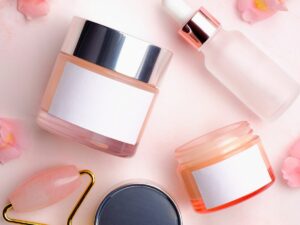
- Product Compatibility: The material should be compatible with the product it houses. For example, some substances may react with certain types of plastic, leading to product degradation.
Dive Deeper Into Our Resources
For some insightful reads, we’ve curated a list of recommended articles just for you:
Still haven’t found what you’re looking for? Don’t hesitate to contact us. We’re available around the clock to assist you.
Conclusion
Choosing the right packaging is a crucial aspect that goes beyond aesthetics; it affects product quality, brand perception, and environmental impact. This comprehensive guide aims to equip you with the essential knowledge needed to make informed choices for cosmetic packaging.
If you are looking for a cosmetic distributor with aesthetic that can elevate your brand, consider partnering with Nako Cosmetic. To discuss your specific needs, feel free to contact us for more information.








